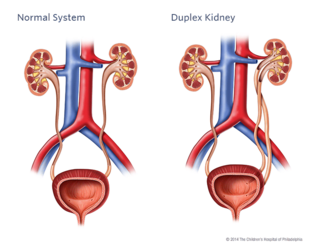What is a duplex kidney?
In a normal urinary tract, each kidney is connected to one ureter (a tube that drains urine into the bladder).
Children with a duplex kidney (also called a duplicated collecting system) have two ureters coming from a single kidney. These two ureters can drain independently into the bladder or connect and drain as a single ureter into the bladder. Duplex kidneys can occur in one or both kidneys.

Duplex kidneys are a normal variant, meaning that they occur commonly enough in healthy children to be considered normal. They occur in 1 percent of the population, and most cause no medical problems and will require no treatment.
Other duplex kidneys can be associated with the following:
Testing and diagnosis
Many duplex kidneys are found incidentally during imaging studies.
Treatment
Since most duplex kidneys are a normal finding, no treatment is necessary. If a duplicated kidney is associated with VUR, an ectopic ureter or a ureterocele, experts in the Division of Urology will follow the treatment plan for those diagnoses.
Reviewed by: Division of Urology
Date: May 2011
Resources to help
Division of Urology Resources
Caring for a child with an illness or injury can be overwhelming. We have resources to help you find answers to your questions and feel confident in the care you are providing your child.


